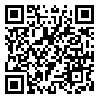Volume 11, Issue 3 ( Autumn 2004)
J Birjand Univ Med Sci. 2004, 11(3): 34-38 |
Back to browse issues page
Download citation:
BibTeX | RIS | EndNote | Medlars | ProCite | Reference Manager | RefWorks
Send citation to:



BibTeX | RIS | EndNote | Medlars | ProCite | Reference Manager | RefWorks
Send citation to:
Ghorbani A, Cheetsaz A, Noorian S. Studying of clinical symptoms and precaution of oculomotor nerve palsy in diabetics. Journals of Birjand University of Medical Sciences 2004; 11 (3) :34-38
URL: http://journal.bums.ac.ir/article-1-221-en.html
URL: http://journal.bums.ac.ir/article-1-221-en.html
1- Assistant Professor, Department of Neurology, Faculty of Medicine, Isfahan University of Medical Sciences, Isfahan, Iran , ghorbani@med.mui.ac.ir
Abstract: (19314 Views)
Background and Aim: Oculomotor palsy (Third cranial nerve) in diabetic patients is presented with opthalmoplegia with pupil sparing. Other factors which can mimic third nerve palsy consist of compressive lesions such as posterior circulation aneurysm. Although these lesions are associated with opthalmoplegia with pupil involvement, in some cases pupil sparing is not a reliable symptom in ischemic neuropathy.
Materials and Methods: In this prospective study, of all patients who were admitted 84 cases with ischemic oculomotor palsy underwent medical treatment at diabetes research center and outpatient Neurology department of Isfahan University of medical sciences. All patients were followed up for one year. Then, the data was analyzed by SPSS package.
Results: In regard to kind of oculomotor palsy all patients were categorized into four groups. Group I: Consisting of complete opthalmoplegia without pupil involvement in which pupil remains intact throughout the study. Group II: having complete opthalmoplegia associated with pupil involvement and absence of aneurysm, was confirmed through the four vessels angiography. But no evidence of aneurysm was detected. In group III and IV with incomplete palsy; two cases of subarachnoid hemorrhages, and two cases of un-ruptured aneurysm.
Conclusion: This study indicated that lack of pupil involvement is not a reliable symptom of diabetic ischemic oculomotor palsy. But incomplete opthalmoplegia should be considered as an alarming sign of existing aneurysm.
Materials and Methods: In this prospective study, of all patients who were admitted 84 cases with ischemic oculomotor palsy underwent medical treatment at diabetes research center and outpatient Neurology department of Isfahan University of medical sciences. All patients were followed up for one year. Then, the data was analyzed by SPSS package.
Results: In regard to kind of oculomotor palsy all patients were categorized into four groups. Group I: Consisting of complete opthalmoplegia without pupil involvement in which pupil remains intact throughout the study. Group II: having complete opthalmoplegia associated with pupil involvement and absence of aneurysm, was confirmed through the four vessels angiography. But no evidence of aneurysm was detected. In group III and IV with incomplete palsy; two cases of subarachnoid hemorrhages, and two cases of un-ruptured aneurysm.
Conclusion: This study indicated that lack of pupil involvement is not a reliable symptom of diabetic ischemic oculomotor palsy. But incomplete opthalmoplegia should be considered as an alarming sign of existing aneurysm.
Type of Study: Original Article |
Subject:
Ophthalmology
Received: 2006/09/6 | Accepted: 2014/01/9 | ePublished: 2014/01/9
Received: 2006/09/6 | Accepted: 2014/01/9 | ePublished: 2014/01/9
Send email to the article author
| Rights and permissions | |
 |
This work is licensed under a Creative Commons Attribution-NonCommercial 4.0 International License. |





